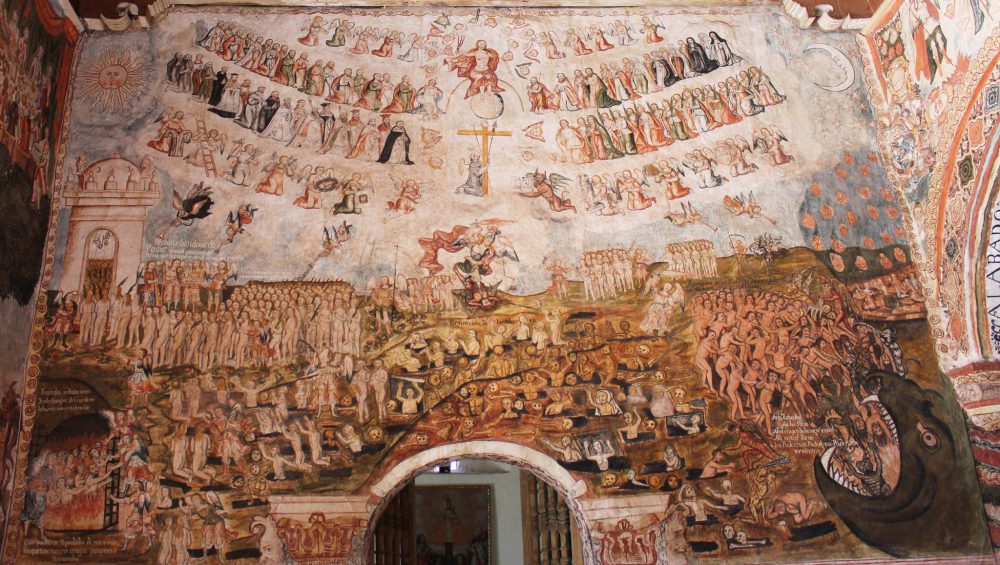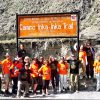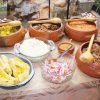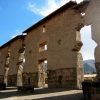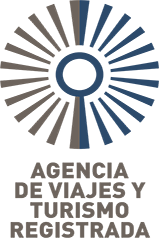It’s located in the Main Square of the district of Huaro Church Tour. Province of Quispicanchis, department from Cusco, 40 km from the city of Cusco.
It has a temperate climate with an average of 10º C, with two defined seasons, rain and the other dry.
The main activity of the resident of Huaro is agriculture. This is why it maintains a constant commercial operation with Cusco and the surrounding districts. With corn being the main production.
CHARACTERISTICS OF THE HUARO CHURCH TOUR.
 In front of a wide atrium that is accessed through three carved stone steps, is the main entrance to the temple, which is descended by two slopes and a carved stone landing. The main portal leads to the first space or basement. To the right of this, there is a staircase with three stone steps and the rest of the rammed earth that leads us to the choir.
In front of a wide atrium that is accessed through three carved stone steps, is the main entrance to the temple, which is descended by two slopes and a carved stone landing. The main portal leads to the first space or basement. To the right of this, there is a staircase with three stone steps and the rest of the rammed earth that leads us to the choir.
Attached to the church in a perpendicular way are the small rooms of the baptistery (wall of the gospel), two side chapels, the sacristy, and the storage of litters as buttresses that make a set of volumes characteristic of the churches of the region.
The largest interior space is occupied by the rectangular nave. Then, the roof of the nave is limited by the triumphal or toral arch that is higher with reference to the main nave. Next is the presbytery which is accessed by a stepped podium of carved stone, on the sides are the entrances to the sacristy and deposit of canvases that guard the chapel, the doors are made of colonial greenwood, in the front wall there is a window with a spill, a wooden frame, and simple glass.
THE WALL PAINTING
 It constitutes one of the first forms of artistic expression of man. Used since pre-Hispanic times. In Hispanic times, during the 17th to 19th centuries, Huaro received different artistic influences from both the European schools and the indigenous influence. Since the arrival of the Spanish to the territory of the Incas, Hispanic and indigenous techniques were mixed in the execution of works of art.
It constitutes one of the first forms of artistic expression of man. Used since pre-Hispanic times. In Hispanic times, during the 17th to 19th centuries, Huaro received different artistic influences from both the European schools and the indigenous influence. Since the arrival of the Spanish to the territory of the Incas, Hispanic and indigenous techniques were mixed in the execution of works of art.
The first drawings executed in the temple of Huaro were apparently in the presbytery, by anonymous authors. Subsequently, the works were expanded towards the gospel walls and the epistle, a wall of feet, and then ascended towards the choir and the ceiling. Most of the wall paintings are the work of Thadeo Escalante and his disciples.
In the 18th century, the decoration went up to the ceilings and vaults. Like an evocation of heaven. From then on, the decoration is carried out throughout the interior space (walls. Ceilings, ceilings, columns. Etc.)
Both mestizos and Indians are increasingly numerous in painters’ guilds. A style that lasts until the middle of the 19th century.
Thadeo Escalante born in Acomayo possibly in 1770 and died in 1840, a descendant of the Incas, executed his works between the end of the 18th century and the beginning of the 19th century. He was a disciple of the Zapata mestizo muralists. Gutiérrez and Vilca.
In Huaro there are five pictorial groups, placed in the following parts of the church: triumphal arch with the apotheosis of San Juan Bautista, patron of the church, nave, arches that support the choir, basement, and coffered ceiling.
Reverse: They reiterate the theme of the Triumphal Arch with San Juan Bautista and San Pedro, as protagonists. In the middle part “La Sagrada Familia”, and on the right side the representation of “Los Ángeles” and “Las Virtudes”.
HUARO CHURCH TOUR WITH US
Sun Gate Tours offers this tour by request. Depends on your customize travel we can do scheduled it with the best options that we have to offer you. Just contact us by email or whatsaap number and we glad to help you anytime!.
Here you have the information:
Email: hello@sungatetours.com
Whatsaap number: +51901994670

